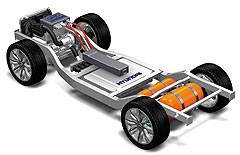Future models - Hyundai - i-Blue FCVHyundai's fuel cell rethinkDelayed: Hyundai says its first cell vehicles will hit the road as late as 2015. Hyundai scraps plans for an SUV-led fuel cell era by showing its i-Blue vision27 Sep 2007 By TERRY MARTIN HYUNDAI has taken a radical turn in its development of zero-emissions fuel-cell vehicles, presenting a non-SUV platform for the first time at the recent Frankfurt motor show and taking a less bullish approach in terms of its date for commercialisation. The i-Blue concept shown in Frankfurt is a massive departure from the first-generation Santa Fe FCV that GoAuto drove in 2004, a time when the South Korean auto giant was moving to the smaller Tucson platform as the new basis for its FCV research and development. The Tucson program was to run until 2009, switching to another SUV that would become its first commercial FCV in 2010. With the i-Blue, that situation has now changed. The official line is that Hyundai is making “tremendous efforts” to make mass production of hydrogen-powered FCVs “a reality in the next decade” – and the company has now specified between 2012 and 2015 as its new timeframe. This is a significant amendment from the 2010 it had been certain of achieving when the Tucson made its international debut in 2004. Furthermore, the confidence Hyundai exhibited in an SUV platform as the most appropriate foundation for FCVs – citing packaging as the key advantage – seems to have eroded with this third-generation FCV, which is based on a unique platform architecture (as far as we can gather) designed for a medium-large 2+2 “crossover” vehicle.  Left: i-Blue platform. Left: i-Blue platform.Previously adamant that an SUV would be the best basis for an FCV, Hyundai senior management now claims this new bodystyle “marks a step ahead on the path to develop mass-production models, as the fuel-cell system is more difficult to integrate in a smaller body type”. Compared to the Tucson FCV, the i-Blue is longer (at 4850mm) and wider (1850mm) but lower (1600mm). Significantly, the fuel cell stack is now under the floor – as it was on the Santa Fe FCV – rather than in the engine bay, which Hyundai’s senior management told GoAuto in 2004 was the best place because it was better protected from potential damage and less susceptible to rust. Hyundai now states that the underfloor positioning of the fuel cell stack enables a desirable 50:50 weight distribution, along with a “less densely populated” engine compartment, which in turn provides better airflow and cooling. Maximum power output from the electrical engine and fuel cell stack is 100kW (up 20kW), the driving range has doubled to 600kW and the maximum speed has climbed to 165km/h (up15km/h). The compressed hydrogen fuel (with 700 bar pressure) is now stored in a 115-litre tank, which is a much more compact size, down from 152L in the Tucson FCV. Few other specifications have been made available following the i-Blue’s Frankfurt debut, but the technical improvements seem promising and the new platform has provided the Korean manufacturer – which is still aspiring to become a top-five automotive powerhouse – with a means to air some unorthodox design elements. According to the car-maker, the exterior styling of the i-Blue resembles “TaeKuk”, which in turn is based on the Ying and Yang philosophy (opposite forces unified in perfect balance). Hence, Hyundai’s designers have attempted to unify two distinct geometric forms – the square and circle – to create a rhombus-like shape. The front end has similar cues to the Genesis large prestige sedan concept shown at the New York auto show in April, while the grille and headlights are expressed as crystal glass art “to depict the water from the fuel cell system”. In a Subaru-like preoccupation with aircraft design, the rear end is said to take the shape of the horizontal and vertical form from the wings of an aeroplane. The rear light cluster is also meant to be associated with stars in space. Similar themes continue inside with an aircraft-inspired steering wheel that integrates touch-scroll control pads. A 3D vision heads-up display, described as a “hologram HUD”, is also onboard and combines with a “full-surround camera system” to eliminate blind spots and provide optimum parking assistance. The i-Blue was developed not in South Korea but Japan, at the company’s design and technical centre in Chiba. The fuel-cell technology is, however, coming out of Korea, at the Eco-Technology Research Institute in Mabuk, which opened in September 2005. Read more:Hyundai FCV push |
Click to shareHyundai modelsResearch Hyundai Motor industry news |














Facebook Twitter Instagram